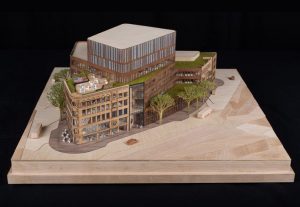For Local Governments
 Download this page as a PDF Here.
Download this page as a PDF Here.
The Advantages of Community Fiber
- Local accountability for an essential service. Improved connectivity of municipal institutions including utilities, schools, hospitals, and libraries.
- Revitalized local economies, increased entrepreneurship, and a healthier business climate. Learn more here.
- A reliable source of public revenue. Local governments that have built their own networks are reaping the benefits. The projected revenues for the 2018-2019 fiscal year from the telecom division of Chattanooga’s fiber initiative were $169.1 million. For more on public savings click here.
- The social and economic benefits of community-owned fiber-to-the-premises are measurable, as this University of Sidney study shows.
- Reduced residential prices with that money being reinvested in the community. This Fact Sheet shows how community-owned networks have kept their prices steady and affordable for many years.
- Increased competition, potentially multiple times over with open access .
- Faster, safer, more reliable connectivity from the latest technology. Faster and better than 5G. Visit our Wired Smart Cities page to learn more.
- Local customer service rather than call centers in distant states or countries.
- Fiber to the home is cheap to upgrade to even higher speeds once it is laid, making it an infrastructure investment that will be good for decades to come.
Moving Forward – First Steps

- Use these fact sheets or this Alberta Community Broadband Toolkit to learn more about fiber optics and community broadband
- Have public meetings to assess current Internet access
- Build a vision, a set of guiding principles for technology that address your political, economic and cultural environment.
- Learn from what other cities have done. This Broadband Strategic Plan from Canmore, Alberta provides an easy to follow model for any local government.
- Hire a consultant who has worked in communities like yours
- Create a committee and work with the ideas below

Best Practices for Success
Bringing municipal broadband to local, rural, native, and remote communities in Canada requires significant levels of planning, collaboration, engagement, governance, and business strategies.
This process involves a close alliance between heads of council, municipal staff (particularly IT and economic development), and the CAO (city manager, head of corporate services, etc.). Residents, businesses, telecommunications companies, ISPs, and technology suppliers will also be engaged and involved.
Implement these 7 Practices to Insure a Fluid Process:
- Elected leaders and staff on the Project Committee must have the political will to realize the goal of community-owned fiber.
- Select committee participants based on skills, knowledge and collaboration ability, not job title.
- Trust and openness are critical. Foster a safe environment where budgets and strategies may be shared with no politics and no media present.
- Dig Once. If you choose to place your fiber underground, adopt a “dig once” policy and install fiber conduits at the same time other municipal infrastructure (road, water and sewer) projects are undertaken.
- Aerial Fiber. If the cost of burying fiber is prohibitive , consider hanging fiber in the air (perhaps on utility poles.)
- Demand Aggregation. Engage in exercises to determine demand within the community.
- Think and Work Regionally. Considering what neighbouring communities and regions are doing may result in cost savings over the long term.
 Municipal
Municipal
Broadband
Models
Municipal Network
- The district, city, or town owns the Internet network infrastructure. These networks often operate as municipal utilities, much like water or electric, but may operate through a variety of models. Some operate purely as infrastructure and allow independent providers to use the infrastructure as a way to offer services to the local community.
- Use this overview to learn more about existing municipal broadband models.
Telephone or Electric Cooperatives
- Member-owned cooperatives fund, build, and manage fiber networks as extensions of their pre-existing telecommunications infrastructure and service. Cooperative solutions tend to be more practical in rural regions.
Public-Private Partnership
- Local governments find a partner they can trust that will share the risks and rewards of a network. The Westminster / Ting partnership in Maryland is a good model.

Financing
- Use this tool to understand the three most common municipal broadband financing models used by communities in the U.S.
- Communities are also using new low risk, low cost techniques to deploy much needed fiber optic networks. Learn more here.
Government Funding in Canada
- To learn more about Canada’s federal Broadband Fund announced in November 2018, click here.
- There is a northern component to federal funding targeting remote, satellite-dependent communities in Nunavut and the Nunavik region of northern Quebec
- And there is a rural component called Connect to Innovate The previous program targeting rural and remote communities was called Connecting Canadians. Here are some of the projects it funded.
- Provincial funding programs are also in place. Learn more about the Connecting British Columbia program here. For programs in other provinces do some sleuthing locally or call your Regional Office of Innovation, Science, and Economic Development Canada listed here.

Next Steps
Once your model and funding are in place, break the job of building the network into manageable chunks and get the right help from trusted partners. Although it will be tempting to totally hand the reigns over to an outside expert, ongoing local input into every step of the process will achieve the best results.
The Four Primary Roles in Building a Community Broadband Network:
- Broadband Committee. This is a local group of interested citizens who oversee the community broadband effort. These dedicated individuals will interview potential providers, apply for grant funds, and solicit bids and review proposals to choose the various contractors involved in building and operating the network and serving customers. Members of this committee may also be chosen to head a governing board. Click here to see how the town of Leverett, Massachusetts has structured its fiber-to-the-home network.
- Design-Build Contractor. Sometimes the design and build functions are separate, but often the same firm that does your network design will have the trucks and personnel to build the network. You may also want an independent Owner’s Project Manager to keep the design-build firm on task.
- Network Operator. A network operator monitors and maintains the electronics on your broadband network. When things aren’t working right, they troubleshoot problems and dispatch technicians when necessary, either from their own crews or third party contractors.
- Internet Service Provider / Telephone Service Provider. On many municipal networks, like the one in Leverett, Massachusetts, a single Internet service provider is awarded a contract to provide service for 3-5 years. The ISP provides the Internet and phone connections over the community’s network, along with ancillary services like email. In addition, the ISP provides end-user technical support and customer service, as well as billing and collecting end-users and remitting the communities portion of the fees to the town.
 Avoid all-in-one Solutions
Avoid all-in-one Solutions
For long-term flexibility and security, have a separate builder, operator, and service provider for your community network.
- The network operator has a stake in ensuring the network is well designed and built. Keeping the network operator independent from the design-build contractor gives you experienced, third-party oversight of the construction process.
- Separating the role of network operator from that of internet service provider will facilitate a smoother transition should you decide to shift who holds either of these positions. If this situation arises, you have a trusted partner with his or her own records, systems, and expertise to help support this change.